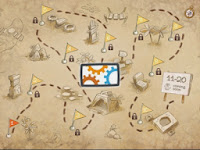- that programs execute by following precise and unambiguous instructions
- to create and debug simple programs
- use logical reasoning to predict the behaviour of simple programs
and KS2:
- design, write and debug programs that accomplish specific goals, including controllingor simulating physical systems; solve problems by decomposing them into smaller parts
- use sequence, selection, and repetition in programs; work with variables and variousforms of input and output
- use logical reasoning to explain how some simple algorithms work and to detect and correct errors in algorithms and programs
(Computing programs of study 2014)
There are 10 levels, with 10 more coming soon.
It starts off with simple steps that are modelled for you, so you can't go wrong.
It quickly moves on to the repeat command, so that our children can make links between this and the previous steps - and the reason for having a repeat command.
The next step is learning about variables in a very simple way. This again is modelled clearly for you.
It encourages children to think about shortening their sequences and creating loops, thus making their algorithms more efficient. A great little app that is free too!







No comments:
Post a Comment
Please be patient, your comment will be posted once moderated.